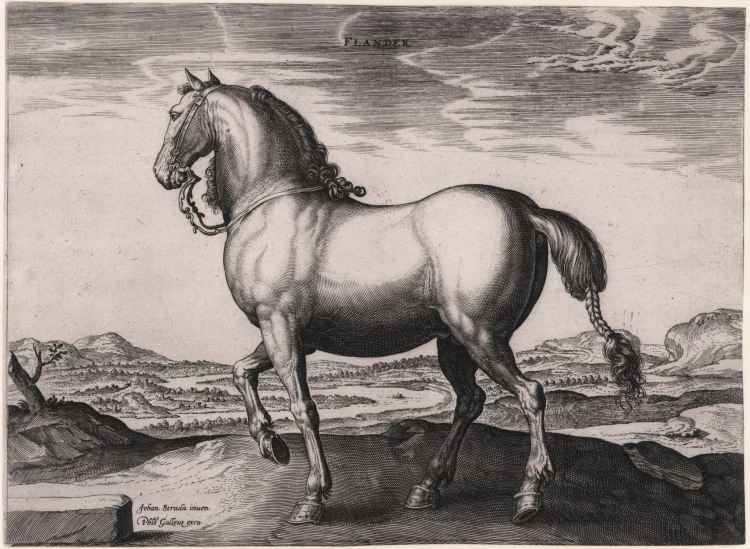




| Reference: | S5203 |
| Author | Hendrick GOLTZIUS |
| Year: | 1579 |
| Measures: | 265 x 195 mm |



| Reference: | S5203 |
| Author | Hendrick GOLTZIUS |
| Year: | 1579 |
| Measures: | 265 x 195 mm |
Plate taken from "Equile Ioannis Austriaci Caroli V. Imp. F. In quoquo omnis generis generosissi: morum equorum equorum ex variis orbis partibus insignis delectus. Ad vivum omnes delineati à celeberrimo Pictore Iohane Stradano Belga Brugensi et à Philippo Galleo editi", a series of forty horses from the stable of Don John of Austria. After Jan van der Straet, called Stradanus (Netherlandish, Bruges 1523–1605 Florence)
The series was begun by Hieronymus Wierix and the title-page is by Adriaen Collaert.
Engraving, without signature. A magnific impression, printed on contemporary laid paper, trimmed to the borderline, very good condition.
Literature: A. Baroni and M. Sellink, 'Stradanus 1523-1605: Court artist of the Medici', exh.cat. Groeningemuseum Brugge 2008-2009, Turnhout, 2012, pp.240-241, cat.nos.28-31.
|
Hollstein, 346; Strauss, 103, I/II.
|
Hendrick GOLTZIUS (Mulbrecht 1559 - Haarlem 1617)
|
Dutch painter and engraver, was born at Millebrecht, in the duchy of Julich.
After studying painting on glass for some years under his father, he was taught the use of the burin by Dirk Volkertszoon Coornlert, a Dutch engraver of mediocre attainment, whom he soon surpassed, but who retained his services for his own advantage. He was also employed by Philip Galle to engrave a set of prints of the history of Lucretia.
At the age of twenty-one he married a widow somewhat advanced in years, whose money enabled him to establish at Haarlem an independent business; however his unpleasant relations with her so affected his health that he found it advisable in 1590 to make a tour through Germany to Italy, where he acquired an intense admiration for the works of Michelangelo, which led him to surpass that master in the grotesqueness and extravagance of his designs. He returned to Haarlem considerably improved in health, and laboured there at his art till his death.
Goltzius ought not to be judged chiefly by the works he valued most, his eccentric imitations of Michelangelo. His portraits, though mostly miniatures, are master-pieces of their kind, both on account of their exquisite finish, and as fine studies of individual character. Of his larger heads, the life-size portrait of himself is probably the most striking example. His master-pieces, so called from their being attempts to imitate the style of the old masters, have perhaps been overpraised.
In his command of the burin Goltzius is not surpassed even by Dürr; but his technical skill is often unequally aided by higher artistic qualities. Even, however, his eccentricities and extravagances are greatly counterbalanced by the beauty and freedom of his execution. He began painting at the age of forty-two, but none of his works in this branch of art--some of which are in the imperial collection at Vienna--display any special excellences. He also executed a few pieces in chiaroscuro.
|
|
Hollstein, 346; Strauss, 103, I/II.
|
Hendrick GOLTZIUS (Mulbrecht 1559 - Haarlem 1617)
|
Dutch painter and engraver, was born at Millebrecht, in the duchy of Julich.
After studying painting on glass for some years under his father, he was taught the use of the burin by Dirk Volkertszoon Coornlert, a Dutch engraver of mediocre attainment, whom he soon surpassed, but who retained his services for his own advantage. He was also employed by Philip Galle to engrave a set of prints of the history of Lucretia.
At the age of twenty-one he married a widow somewhat advanced in years, whose money enabled him to establish at Haarlem an independent business; however his unpleasant relations with her so affected his health that he found it advisable in 1590 to make a tour through Germany to Italy, where he acquired an intense admiration for the works of Michelangelo, which led him to surpass that master in the grotesqueness and extravagance of his designs. He returned to Haarlem considerably improved in health, and laboured there at his art till his death.
Goltzius ought not to be judged chiefly by the works he valued most, his eccentric imitations of Michelangelo. His portraits, though mostly miniatures, are master-pieces of their kind, both on account of their exquisite finish, and as fine studies of individual character. Of his larger heads, the life-size portrait of himself is probably the most striking example. His master-pieces, so called from their being attempts to imitate the style of the old masters, have perhaps been overpraised.
In his command of the burin Goltzius is not surpassed even by Dürr; but his technical skill is often unequally aided by higher artistic qualities. Even, however, his eccentricities and extravagances are greatly counterbalanced by the beauty and freedom of his execution. He began painting at the age of forty-two, but none of his works in this branch of art--some of which are in the imperial collection at Vienna--display any special excellences. He also executed a few pieces in chiaroscuro.
|